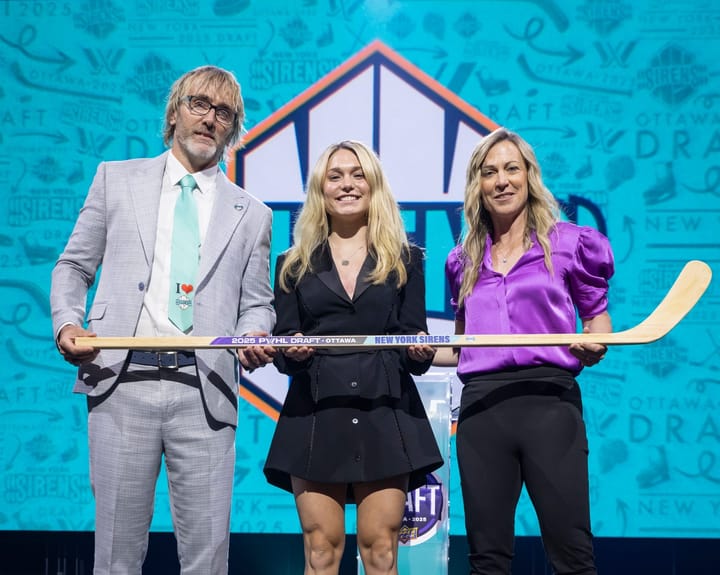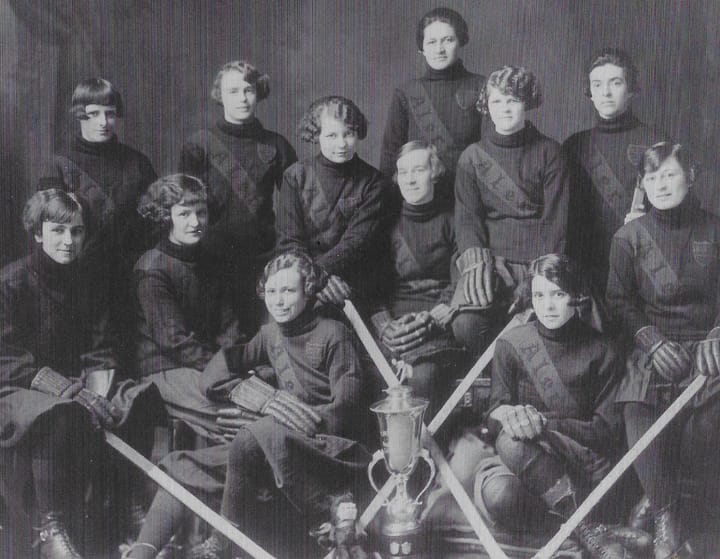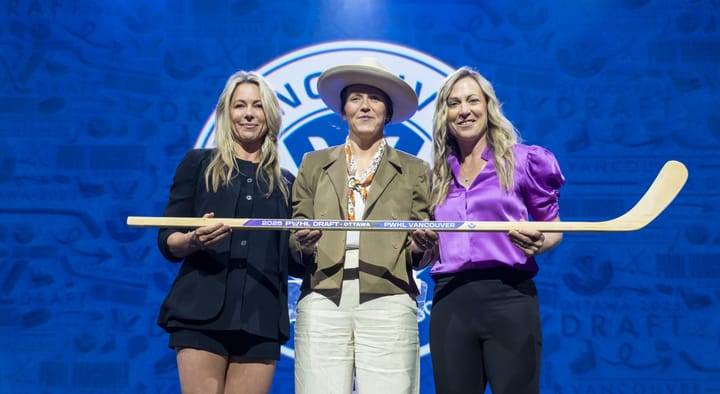Breaking down the PHF’s salary disclosure policy
The how, why, and what’s next of salary transparency
After an important battle fought by Players Association reps and others, PHF players now have a way to share their salaries. There are a lot of wrinkles to this story — some of which are still emerging — but, looking at the big picture, this is a significant win for the PA. Players came together and, through the PA, worked with the league to address an obstacle standing in the way of salary transparency by making a change to standard player agreements.
Players and their agents will now have access to information that wasn’t in the public sphere. This information can help establish a marketplace and will help players and their agents in contract negotiations. This makes the playing field between players and their teams and the league a little more level than it was a week ago. But, there are definitely some key details on the procedure of disclosure that deserve our attention.
A Mutual Agreement
The system now in place allows for salary disclosure and other details through the league in signing announcements which, The Ice Garden has learned from the PHF, is to prevent misinformation from spreading.
One way to look at this is the league having a lot of control over something that could and some may argue should be completely left up to players. From the league’s perspective, there is a purpose to overseeing how this information gets out.
TIG has also learned that some of the estimated salaries that reached the public may have been inaccurate. According to the league, “This policy is designed to ensure there is a uniform and standardized approach to disclosing salaries.” Now, there’s a standard procedure for disclosing, which feels a lot like a continuation of what the league did before NDA and confidentiality clauses prohibited players from sharing what they made. Remember, players had the option to disclose their salary in 2019-20 and the league shared all player salaries in 2015-16 and in 2016-17 before salaries were cut mid-season.
Related
PHF announces option for players to disclose salary
Wicked Angles: Longtime salary silence in FA shows how far PHF has yet to go transparency-wise
As things currently stand, if a player wishes to disclose any of the terms of their contract — including salary, AAV on two-year deals, or bonuses — they must “mutually agree” on what is disclosed and when it is disclosed with their general managers. In many cases, that will be when signings are announced. This should prompt the PHF to encourage teams to issue true press releases for every signing — a standardized release procedure for all signings, in the interest of transparency. This shouldn’t be an issue in the first place, but it is.
The Ice Garden and others sought out additional clarification from the league on this “mutual agreement”. We can report that a general manager cannot completely prevent a player from disclosing — general managers (which is to say teams) have a say on the “when” not the “if” of disclosure. Alex Azzi of NBC Sports reported that, per Nicole Corriero, “the Team cannot object to the Salary Disclosure.” Why a general manager would stand in the way of this is an important conversation that needs to take place. Why would and should this take priority over a player’s wishes? Speaking bluntly, this feels like teams and general managers not wanting to show their cards in negotiations and signings until they absolutely have to.
In such cases where a manager may not want the terms of a deal disclosed at the time of signing, details will be shared by the league no later than the beginning of the regular season. So, we have a timeline in place for any salaries where a player agrees to disclosure but a manager may not. This means that we should have all of the contract information that signed players want to disclose before the first game of the 2022-23 season.
Seeking further clarification on disclosure and the if it can exist outside of the league sharing information, TIG learned the following important detail in an email correspondence with the league:
“The mutual agreement ensures both the player and GM are in agreement on when the terms are disclosed (in conjunction with their player signing announcement). The policy does not allow for one party to disclose without the other party being in agreement.”
From the outside looking in, it appears that players disclosing contract information with media is (still) discouraged. This, too, raises questions. Why must general managers sign off and do players have a direct path to disclosure through the PA and the league? This would feel less problematic if there was a clear border separating teams from the league itself — but there’s not. The Boyntons (BTM Partners) own four of the league’s seven teams. There’s also the issue of the PA not being a true union, thus there is no CBA.
"I don't see a scenario where our league will go after any players (for disclosing their salaries). That sounds pretty aggressive and not the kind of relationship we want with players." -PHF Commissioner Reagan Carey
— Mike Murphy (@DigDeepBSB) July 12, 2022
(Question from @AlexAzziNBC in today's press conference)
When and if that all changes are much bigger questions, but all of this should be kept in mind when digesting this development in salary transparency. So, to boil it down, if salary disclosure happens it will be through the league.
At the end of the day, if a player wants to share their salary to help their peers, they can. That is a big deal and, in my opinion, represents an important victory for players. Considering all of the factors here, this was not a guaranteed “win” for the PA, its Executive Director, and its reps. But here we are.
“As the League continues to grow and move forward, I think it’s important that we take steps to emulate other professional sports leagues to show that the PHF is here to stay,” Beauts’ PA rep and star defender Dominique Kremer shared in a league release. “One way to do that is by disclosing the monumental increases in salaries for PHF players. Not only does it prove to people that the PHF is striding towards making professional women’s hockey a full-time career, but also gives that younger generation of girls something to work towards for their future.”
All things considered, this is a big stride in the right direction for transparency. We may not have all of the pieces of the puzzle, but we have those that players feel comfortable sharing right now. When the day comes that the league minimum is two or three times what it is now ($13,500) maybe we’ll have a clearer picture. Until then, a lot of good can still be done when we know only some of the salaries.
“We, as a PA, felt it was super important to give this resource and transparency to players that felt comfortable enough to disclose their salaries,” Beauts PA rep and winger Autumn MacDougall told TIG. “Nicole and Reagan did a tremendous job working with our player reps to come up with a solution that would be best for all of the players. Ultimately, what we agreed on is a huge step in the right direction for our league and I’m super proud of everyone involved to make this work.”
Why This Matters
There’s a lot to unpack here, which highlights why all of this was worth the efforts of those who made it happen.
When players know what their peers are making, they can better negotiate for themselves (and most do). When the PA, media, and fans know what players are making, they can better keep account of teams (and therefore the league) spending to the cap ceiling and not hovering just above the cap floor. And the timing of this matters now more than ever before because the landscape of pro women’s hockey changed dramatically over the summer.
“We thoroughly discussed this issue among our player reps to canvas all potential benefits and drawbacks from the player’s perspective, and are encouraged by the collaborative process with Reagan and the League that led to this outcome,” Nicole Corriero, Executive Director of the PA said in the league’s release. “Transparency of salaries can help set industry benchmarks and assist others with their own negotiation process, however every player’s experience and circumstance is unique, and it is understood and appreciated that not everyone wants nor benefits from disclosing personal information. We wanted to work with the League on a policy that encourages and respects both of these mutually important considerations, and we’re pleased that the result of our collaboration provides options that may benefit all.”
That players have the option to disclose at this stage is critical. The PA or the league making disclosure compulsory could do harm in some cases. One example shared with me was a player not wanting their other employer to know what they were making as a pro athlete. There may be players who take less to fit under their team’s cap or to play for a certain team. There may be some who don’t want to read fans and media discussing what they are making on social media in a sport where athletes are closer to both parties than we see on other playing fields. All of these reasons (and others) are valid.
No player should ever feel obligated to share information about compensation that they don’t want to. But the choice to share and disclose one’s salary should be there. And now it is. This can and will help pro players, both present and future in and outside of the PHF.
Transparency Project
As many of you know, this is a story I have been following closely and have played a small role in. In this pursuit of transparency, I was trying to expand on the work I’ve done with women’s hockey stats by creating another public resource — one that would directly benefit athletes I greatly admire. I was not chasing a story, which is why reporting on this process as it unfolded was simply not my priority.
In March, after reports of Mikyla Grant-Mentis’ contract emerged, I began a project to create a public database of pro women’s hockey player salaries. The purpose was to provide a resource for players who had yet to negotiate or were currently negotiating a contract for the 2022-23 PHF season. My belief then and now is that (optional) salary transparency levels the playing field between players and those who they negotiate with.
After sharing the salaries of five players — excluding the deals of Grant-Mentis and Brittany Howard — and adding them to a public Google Sheet it was brought to my attention that PHF salaries had NDA/confidentiality clauses. As a direct result of this discovery, I immediately made the Sheet private to protect players and their deals. Shortly thereafter, I made the Sheet accessible only to players by sharing the link with PA reps from five of the league’s seven teams — those who I had a means of contacting directly.
It is important to note that I have never seen a PHF player contract — and, if I ever did, I would have only a lamen’s understanding of its contents. I am not a lawyer and do not pretend to have any expertise in this area.
For those who may have missed it, I gave a presentation about this project and salary transparency at WHKYHAC 2022. Of course, much of this information is now dated but it still provides some context and history to better understand where we find ourselves now.
My slides for #WHKYHAC 2022https://t.co/VvkzydZRYQ
— Mike Murphy (@DigDeepBSB) July 9, 2022
What Comes Next
So, where are we now?
We’re at a place where players have a resource that they didn’t have last week and, in my opinion, the PA and its reps achieved something significant. From what I understand, the PHF was open to the idea of transparency but that should not diminish what transpired. There’s been a change to the language of the standard player agreement that gives players a choice that they didn’t have before.
It’s important that, as of the writing of this article, we have salaries or estimated salaries of 23 players. That’s nearly one out of every three players. This isn’t just the players who are making the most — this is new players, all-stars, veterans, forwards, defenders, and goalies sharing their salaries. We have a player who was willing to share that she is making the league minimum and other players who are sharing they are making less than an estimated average of $37,500 (based on a 20-player roster).
Related
All of them chose to disclose not just to show that the PHF is, indeed, signing big checks. The conversations I’ve had over the last few months have made it clear that players are sharing what they make to make the road a little easier for the next player who is negotiating a contract. They are sharing their contract details because they think it is important for the game. For the big picture. That, in my opinion, is the real story here. That is what makes me think that we have only scratched the surface of what the PA and its players can achieve.
Taking a step back to look at the big picture, this development could influence the environment of the pro game across the globe, including the PWHPA’s league when it gets rolling. If nothing else, PHF players having the option to disclose their deals allows players to make more informed decisions about what they could and should make. That could influence negotiations between SDHL players and their general managers. And it is all but guaranteed to influence how players negotiate deals with teams in the rising PWHPA league.
The question now is will the PWHPA league and its players pursue a similar path to salary disclosure? Will the European leagues take this into consideration if more European players begin to consider what they can make in the PHF? We’ll find out. One way or another.
Seeing AAV in #WoHo 💪🏽
— Erica L. Ayala (Eye-Yah-La) 💪🏽 (@elindsay08) July 21, 2022
Stick taps to the PHFPA & S/O to @DigDeepBSB.
As I’ve reported before, the neither PWHPA nor Secret CA disclosed the stipends or bonus structure for the Dream Gap Tour. This info should be public moving forward. #EqualPay fights require transparency.
Additional details of this story that may still be emerging. The Ice Garden will continue its coverage and analysis as those details emerge. Finally, our tracker has also been updated to include all salaries disclosed by the league.





Comments ()